What's your pleasure when it comes to observing? Comets? Supernovae? Occultations? Get a sample of each (and more!) in the upcoming week.
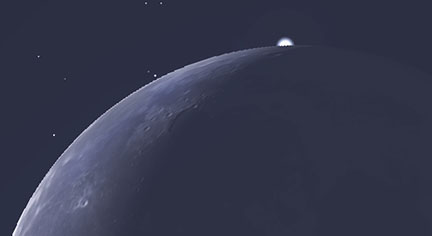
Stellarium
I like a busy observing week the same way I like a buffet. Just grab a tray and head for the steaming entrees that beckon from under the heat lamps. Hmm ... I'll take one of this, one of that, and maybe two of those.
Get your tray ready. With the Moon on vacation from the evening sky, we'll have our best look at the current brightest comet, ASASSN1 (C/2017 O1), and the supernova 2017gxq in NGC 4964. Then on Sunday morning, October 15th, the Moon occults Leo's brightest star, Regulus. All this action is followed by a close conjunction of the Moon and Mars on the 17th.
Don't forget to leave room for dessert. The day after the occultation, the pre-dawn sky will be dark enough to hunt down a new-old fall comet, 24P/Schaumasse. Assuming good weather, we'll all need a nap by Sunday afternoon.
Comet ASASSN1 (C/2017 O1)
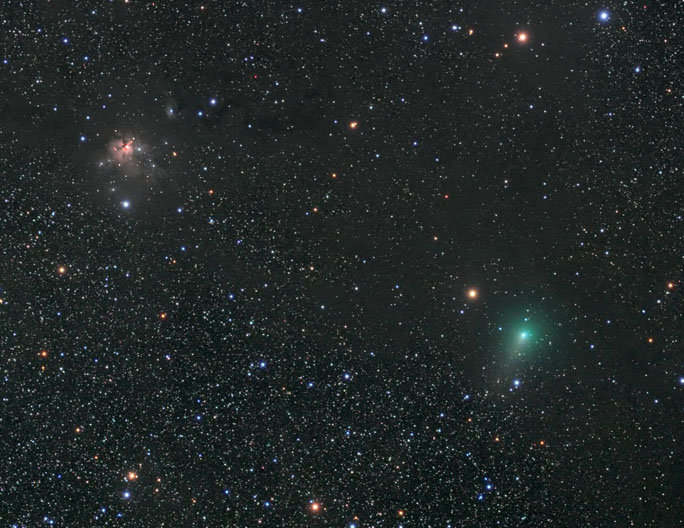
Damian Peach
We last visited this comet in late July shortly after its discovery in the constellation Cetus by the All-Sky Automated Survey for Supernovae (ASAS-SN) team. Back then, it shone at around magnitude 10. Steadily tracking northward since, the comet has brightened modestly to its current magnitude of around 9. According to NASA's JPL HORIZONS site, it should peak in brightness next week and then slowly fade in the months ahead. Closest approach to Earth of 107.7 million kilometers occurs on October 18th.
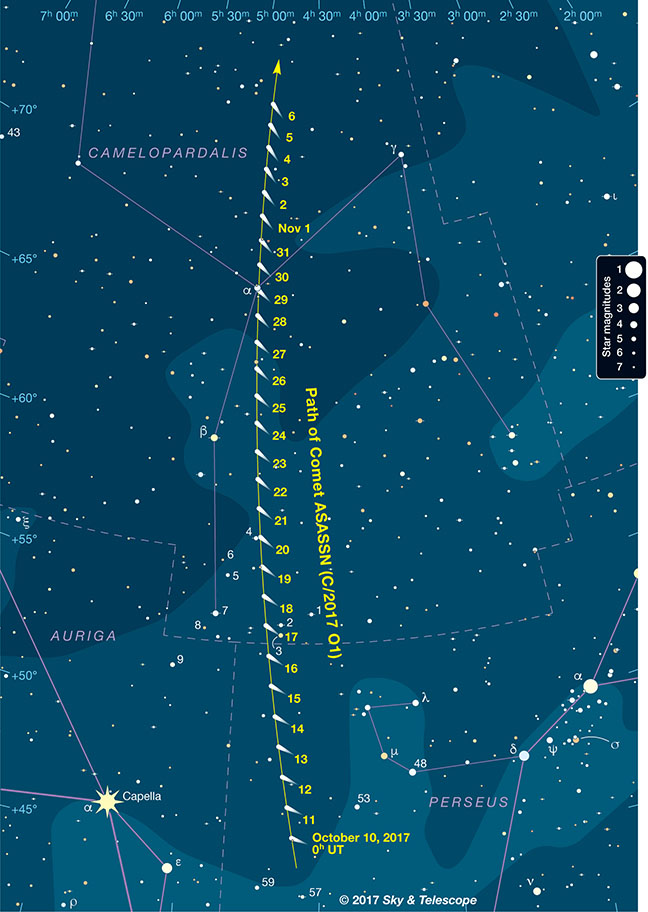
Sky & Telescope
It's certainly hell-bent on heading north. After hopping through Perseus, it crosses into Camelopardalis next week, becoming circumpolar for much of the United States, Canada, and Europe. Later this season, C/2017 O1 rents a cabin at the north celestial pole, lingering within 3° of the North Star from November 30th through December 15th. Northern hemisphere skywatchers will have numerous opportunities to get acquainted with the fuzzy fellow.
I observed C/2017 O1 most recently on October 10th with a 15-inch telescope at low magnification (64×) and saw a big, hazy glow. You wouldn't call it bright overall, but the comet has a ghostly look just right for the Halloween season. I estimated its diameter at 10 arcminutes across with a slightly condensed core (DC=3 in comet parlance). A Swan Band filter boosted its contrast a moderate amount, indicating that the object emits a significant amount of gas. Observers using an 8-inch or larger scope should have no problem spotting it, especially from 9:30 p.m. local time onward, when the comet will be ~20° high and climbing.
Supernova 2017gxq in NGC 4964
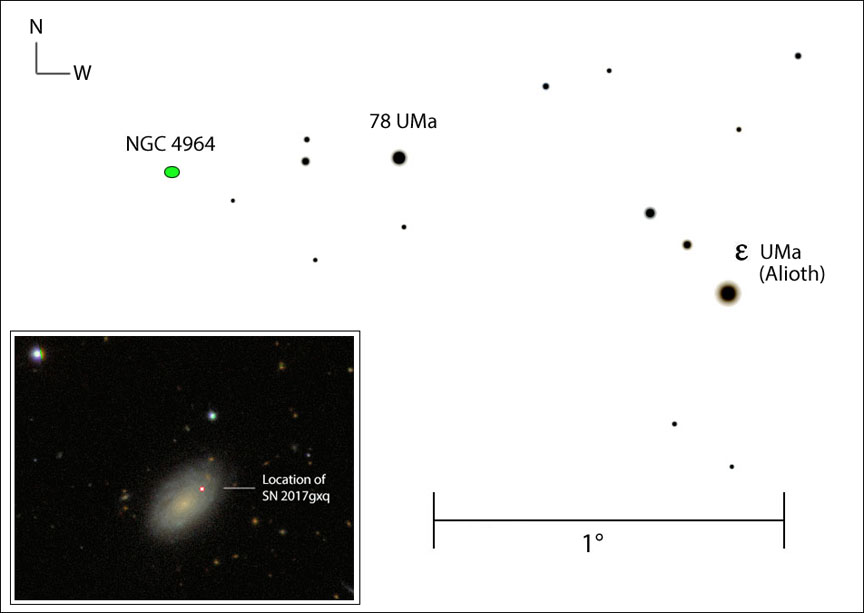
Stellarium and SDSS (inset)
Got an 8-inch or larger scope? You should have no problem seeing this Type Ia supernova in the small galaxy NGC 4964 in Ursa Major. Discovered on September 17th by the Gaia spacecraft at magnitude 17, it quickly rose to 13.6 in earlier this month. I confirmed it at that brightness on October 8th. Despite poor seeing, it was easily visible at 145× in the 15-inch about 15-20 arcseconds northwest of the nucleus nestled within the galaxy's periphery.
Although NGC 4964 is only magnitude 13 and about 1 arcminute across, it's very easy to find tucked between Mizar and Alioth in the handle of the Big Dipper. Click here for a photo, then come see what a white dwarf looks like when it cashes in its chips in a runaway fusion explosion. It can't be pretty if you live there, but from 116 million light-years away, the view is fantastic. For updates, see David Bishop's Latest Supernovae site.
Regulus Occultation
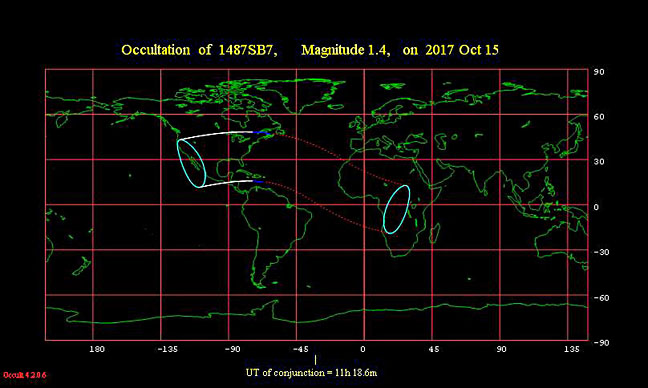
Occult 4.2
On Sunday morning, October 15th, the Moon, about four days before new, occults magnitude 1.4 Regulus for much of the United States and Central America. Exciting as it will be seeing the bright crescent cover the star, the best part will be watching its reappearance along the Moon's dark limb minutes to more than an hour late,r depending on your location. The sudden burst of starlight after the star's "dark passage" should be a spectacular sight visible with any instrument, including the naked eye.
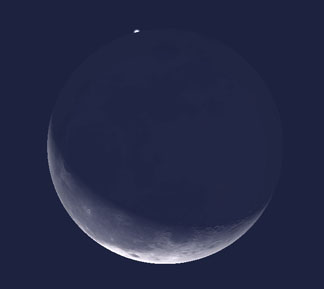
Stellarium
According to occultation expert David Dunham, only New England will have to contend with bright twilight when Regulus returns to view. Most other locales will either be dark or in early twilight. Click the map above for a list of more than 700 cities with times of disappearance and reappearance.
Times are in UT, so remember to subtract 4 hours for Eastern Daylight, 5 for Central, 6 for Mountain, and 7 for Pacific. Observers along a line from western Oregon through Montana, North Dakota, and Minnesota will see a grazing occultation, with Regulus popping in and out of view between lunar valleys and towering crater rims along the Moon's northern limb.
The occultation also provides a rare chance to record Regulus's 12th-magnitude white dwarf companion discovered in 2005. If you're doing low-light video recording, watch for it to appear briefly at the dark limb just ahead (we hope) of Regulus. Astronomers still aren't exactly sure of its position in relation to the bright star.
Moon and Mars 1° Apart
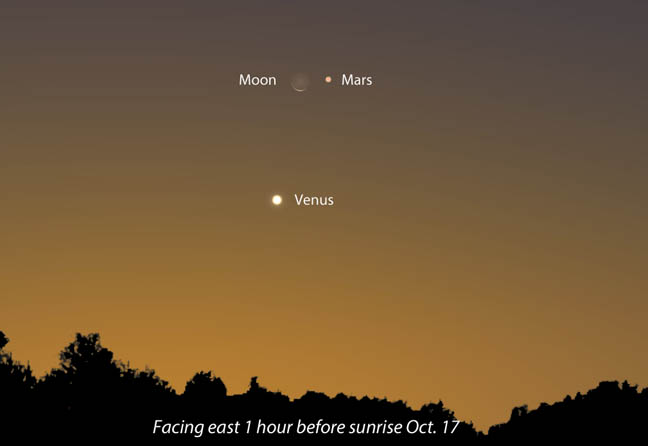
Stellarium
A delicate Moon passes just 1° north of Mars on Tuesday, October 17th. Watch for the pair 90 minutes to an hour before dawn low in the eastern sky. Earthshine will be bright and obvious, making the scene especially beautiful in binoculars.
24P/Schaumasse's Long-Awaited Return
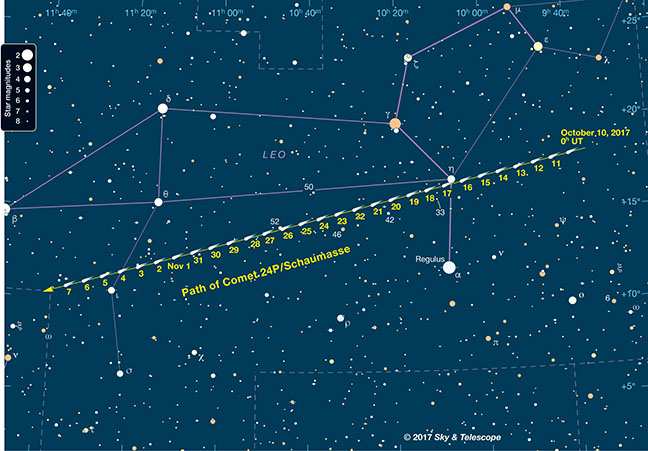
Sky & Telescope
Although this comet revisits the inner solar system every 8.2 years, it was missed on its last return in 2009 because perihelion occurred on the opposite side of the Sun from Earth. This time it's back in great form and slowly brightening as it travels across Leo in the pre-dawn sky. Currently at magnitude 11, the comet is expected to peak around magnitude 10 in mid- to late November, the same time it's closest to Earth (219 million km) and at perihelion. Observers describe it as small and weakly condensed at the moment, but it should intensify in the coming weeks.
I hope you'll enjoy the buffet, the best in the universe, I hear. Don't forget to recommend it to your friends!
 19
19








Comments
Graham-Wolf
October 12, 2017 at 11:29 pm
Hi Bob
Thanks again, for an excellent potpourri/ buffet of celestial objects events this week.
Sadly losing Comet ASASSN 1 as it passes some 7 deg to the left of Capella, in Auriga. Too far North for me. BUT, I've been following 24p/Schaumasse in Leo... loose one, gain one!
Thanks for the findercharts, Bob.
Also, the notice of the forthcoming Lunar Occultation of Mars
Plenty to be happy about.
Thanks once again.
Regards to all.
Graham
You must be logged in to post a comment.
Bob KingPost Author
October 13, 2017 at 9:06 am
You're welcome, Graham. Sorry you're losing a comet, but like you said, there's usually another not far behind. Have you been watching 29P this season?
You must be logged in to post a comment.
Tom Hoffelder
October 13, 2017 at 11:10 am
A few friends and I easily saw the SN in a classic 13.1 Coulter Odyssey on Tuesday, and I was able to see the comet in our 8 inch f/6 Meade Newtonian last night. Two outta three ain't bad. It took averted viewing, maybe even a little averted imagination, to see the comet. It is amazing, nay ridiculous, how dim an 8th mag comet can be. Someone needs to start publishing surface brightness numbers for comets; integrated magnitudes are completely meaningless for them when it comes to good old observing.
You must be logged in to post a comment.
October 13, 2017 at 9:27 pm
excellent point, to describe this vaporous waft of fuzz as 8th (or even 9th) mag is to create a very misleading impression, imo.
You must be logged in to post a comment.
Bob KingPost Author
October 14, 2017 at 9:28 am
Goodricke,
Please send my response to rocksnstars.
You must be logged in to post a comment.
Bob KingPost Author
October 14, 2017 at 9:28 am
Hi Rocksnstars,
The problem I'm seeing with this comet, now that we've had some clear skies for me to observe it on several occasions, is its relatively large size and low surface brightness. If were just an arc minute across, its magnitude would be closer to 10.5, but the coma is large, and when you take that into account in making a magnitude estimate, overall the comet is around mag. 9.
You must be logged in to post a comment.
Tom Hoffelder
October 16, 2017 at 6:34 pm
Hi Bob, I should change that to my real name, Tom Hoffelder. Your reply is a good summary of the problem with mag vs SB. Don't know if you've ever observed the interesting little galaxy group of NGC 4169/73/74/75, but it is an excellent way to show the difference in the two ways of indicating brightness. The magnitudes are: 4169, 12.2; 4173, 12.7; 4174, 13.5 and 4175, 13.4. From that you would think, oh, 4173 is the second easiest to see. Not even close - because it is considerably larger than the other three, it is by far the hardest to see! Surface brightness tells the real story: 4169, 12.6; 4173, 13.9; 4174, 11.8; 4175, 12.9.
You must be logged in to post a comment.
Bob KingPost Author
October 16, 2017 at 9:03 pm
Hi Tom,
I know exactly what you mean. That group sounds like a perfect example - thanks!
You must be logged in to post a comment.
Anthony Barreiro
October 13, 2017 at 4:04 pm
I was hoping to look for C/2017 O1 Saturday night, but sadly here in the SF bay area, it's hard to see much through the smoke from the wildfires.
Also, Robert Ferguson Observatory in Sugarloaf State Park has been evacuated and probably has been lost. Volunteer docents were able to remove their 20-inch Richey Chretien telescope and the primary and secondary mirrors from their 40-inch Newtonian, and some historic equipment. RFO is a volunteer-run organization that focuses on public outreach. Great people. It's a shame. http://rfo.org/ .
You must be logged in to post a comment.
philip-gardner
October 14, 2017 at 6:24 am
Very sad to hear the terrible loss of life in California and potential loss of an observatory. Here in Australia a wild fire took out Canberra's Mount Stromlo in 2003 and it has not recovered nor been replaced. These were large telescopes, 36 inch I think and had only just been renovated and refitted. I went up there last year and it was pretty depressing to see the domes or what was left. They claimed the remains were a memorial to the loss but all I saw was the wreckage. We almost lost our only remaining large observatory at Siding Springs, Coonabarabran also very recently in another wildfire. Only luck saved it. Good luck and we all hope the weather changes for the better.
You must be logged in to post a comment.
Bob KingPost Author
October 14, 2017 at 9:25 am
Sorry to hear this sad news, Anthony.
You must be logged in to post a comment.
Anthony Barreiro
October 16, 2017 at 1:09 pm
I heard second-hand that the Robert Ferguson Observatory survived the fire, but I have not been able to confirm that. Fingers crossed. I'll post an update when I have more info.
The fires are a tragedy, with 42 confirmed dead so far, more than 100 still missing, 6000 homes and other buildings destroyed, and over 200,000 acres burned. That's over 300 square miles or 800 square kilometers.
You must be logged in to post a comment.
Anthony Barreiro
October 24, 2017 at 2:28 pm
RFO posted on their web page and facebook page that the observatory survived the fire, thanks to the firefighters! 75% of Sugarloaf Ridge State Park, where the observatory is located, burned, but the firefighters saved the observatory and other park buildings. Once they clean up the mess and reinstall the telescopes, they'll be back doing public outreach. (S&T should write a story about this.)
You must be logged in to post a comment.
robin_astro
October 13, 2017 at 6:00 pm
Bob,
You might be interested to know that sn2017gxp was confirmed spectroscopically as a supernova (type 1a) by me using a spectrograph specially modified for this work. As far as I know I am the only amateur routinely classifying supernovae. You can see the spectrum on the Transient Name Server website
https://wis-tns.weizmann.ac.il/object/2017gxq
Robin
http://www.threehillsobservatory.co.uk
You must be logged in to post a comment.
Bob KingPost Author
October 14, 2017 at 9:25 am
Thank you, Robin for letting us know. And thanks for your prompt work in classification. I rely on it to better visualize the type of event I'm observing.
You must be logged in to post a comment.
Tom-Reiland
October 14, 2017 at 3:14 am
I finally had an opportunity to observe the Supernova, SN 2017 gxq, in NGC 4964. I used the 21" scope at Wagman Observatory. I estimated it at 13.6 mag, also. It was easier to spot than the galaxy because of the seeing and its low position in the NNW. I got it before the roof of the Dave Smith Hospitality Room got in the way. This is SN #100 for me. Nice to finally hit the century mark. I didn't bother with either comet because I observed them before and neither is worth the effort for an additional observation. I'm hoping that conditions are good for the occultation of Regulus.
You must be logged in to post a comment.
Bob KingPost Author
October 14, 2017 at 9:24 am
Congratulations, Tom on your milestone!
You must be logged in to post a comment.
October 16, 2017 at 2:44 pm
I viewed the reappearance of Regulus from the Baldwin Hills area of Los Angeles CA Sunday morning (The disappearance occurred before moonrise). The event occurred with the moon just a few degrees above the horizon. The hills' elevation kept trees from blocking my view, but the view across the city lights, combined with atmospheric dimming near the horizon, made this a binoculars-only event.
You must be logged in to post a comment.
Bob KingPost Author
October 16, 2017 at 3:50 pm
Thanks for sharing your observation. I can imagine from LA that the pair was low indeed!
You must be logged in to post a comment.
You must be logged in to post a comment.